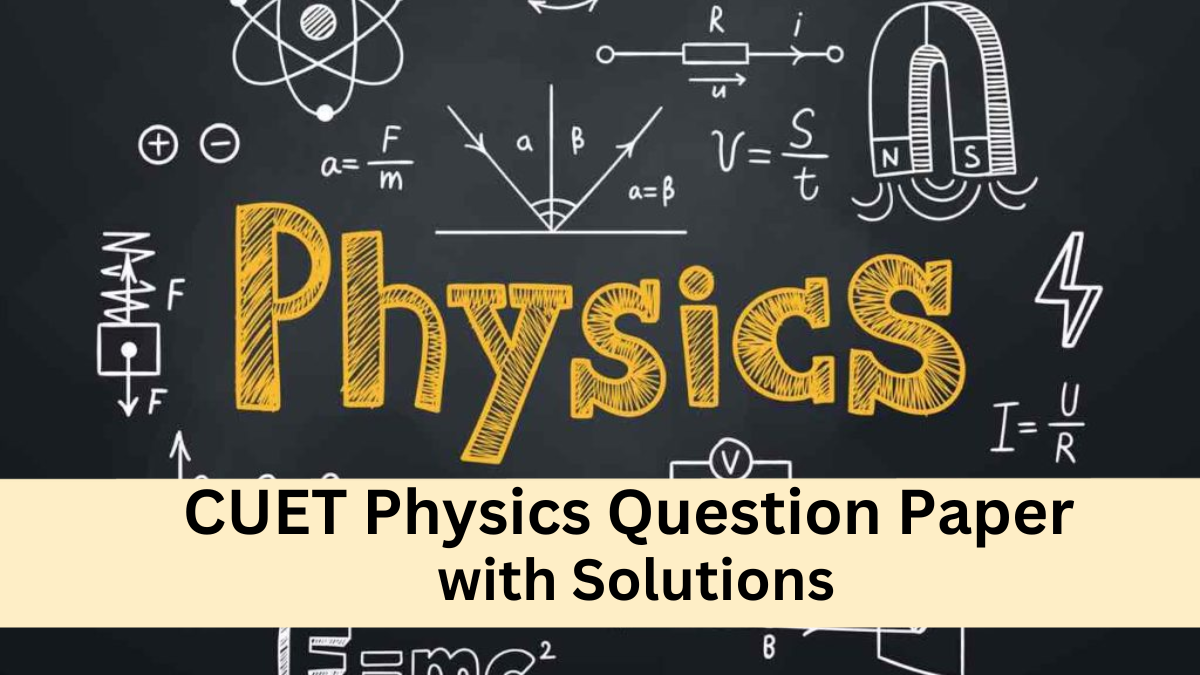CUET Physics Question Paper 2026: For the academic year 2026-27, the CUET Physics 2026 exam is expected to be held in the month of May 2026. To score full marks in the CUET UG 2026 Physics Paper, candidates need to practice the CUET Physics previous year question paper. After the conclusion of the exam, we present the CUET Physics Question Paper 2026 with detailed solutions on this page. The previous year papers and CUET UG 2026 Physics Question paper will assist you in understanding the types of questions asked and also help to predict your scores in the physics paper.
CUET Physics Question Paper 2026
We will soon upload the CUET Physics Question Paper 2026 PDF with answers on this page. Applicants need to work on and solve the CUET physics previous year question paper PDF to understand the exam more effectively. This preparation strategy will assist candidates in becoming acquainted with the exam structure, grading system, and the exam’s difficulty level. The Physics question papers from past CUET exams can also be downloaded through the links given below.
CUET Physics Previous Year Question Paper PDF Download
Students can easily download the CUET UG Physics previous year question papers with solutions in PDF format from the table below. These papers are a great way to understand the exam pattern, types of questions, and important topics. Solving them will help you practice better and improve your chances of scoring high in the exam. Just check the table below, pick the year you want, and start your preparation with the right resources. It’s simple, helpful, and completely free.
| Exam Year | Question Paper PDF Download Link |
| 2024 | CUET Physics Previous Year Question Paper 2024 |
| 2023 | CUET Physics Previous Year Question Paper 2023 |
| 2022 | CUET Physics Previous Year Question Paper 2022 |
CUET 2026 Physics Question Paper
The National Testing Agency (NTA) makes the official CUET Physics question paper available on the official website. Candidates can improve their time management abilities and finish their preparations by practicing and solving the CUET UG physics question paper 2026. According to the CUET exam pattern, the CUET Physics question paper will contain 50 questions, with candidates required to attempt all 50 questions. The CUET Physics question papers from the previous years are available below.
CUET UG Physics Question Paper 2026 Important Topics
Students can check the CUET Physics question paper 2026 weightage below.
| Unit Number with Name | Important Topics | No. of Questions expected |
| Unit I: Electrostatics | Electric Charges and Electric Fields | 3 |
| Electrostatic Potential and Capacitance | 7 | |
| Unit II: Current Electricity | Current Electricity | 6 |
| Unit III: Magnetic Effects of Current and Magnetism | Moving Charges and Magnetism | 5 |
| Magnetism and Matter | 5 | |
| Unit IV: Electromagnetic Induction and Alternating Currents | Electromagnetic Induction | 1 |
| Alternating Currents | 4 | |
| Unit V: Electromagnetic Waves | Electromagnetic Waves | 5 |
| Unit VI: Optics | Ray Optics and Optical Instrument | 4 |
| Wave Optics | – | |
| Unit VII: Dual Nature of Matter and Radiation | Dual Nature of Matter and Radiation | 2 |
| Unit VIII: Atoms and Nuclei | Atoms | 2 |
| Nuclei | ||
| Unit IX: Electronic Devices | Electronic Devices | 5 |
| Unit X: Communication Systems | Communication Systems | 1 |
CUET UG Physics Question Paper 2024 with Solutions
The CUET Physics previous year question papers with solutions have been shared below for the CUET 2026 aspirants. Checkout the important questions and answers for the CUET UG Physics paper from the last year to know what types of questions to expect in the exam.
Q) A point source causing photoelectric emission from a metallic plate is moved away from the plate. The variation in photoelectric current with distance from the source is correctly represented by the graph
Ans: Option (iii)
Q) A wire carrying current I, bent as shown in the figure, is placed in a uniform field B that emerges normally out from the plane of the figure. The force on this wire is
Ans: (i) 4BIR, directed vertically downward
Q) The shortest wavelengths emitted in the hydrogen spectrum corresponding to different spectral series are under:
Ans: (ii) (A), (C), (B), (D)
Q) Two nuclei have mass numbers A and B respectively. The density ratio of the nuclei is
Ans: (iv) 1:1
Q) The kinetic energy of an electron in ground level in hydrogen atoms is K units. The value of its potential energy and total energy respectively are.
Ans: -2K, -K
Q) The transfer of an integral number of_is one of the evidence of quantization of electric charge.
Ans: (iii) electrons
Q) When a slab of insulating material 4mm thick is introduced between the plates of a parallel plate capacitor of separation 4 mm, it is found that the distance between the plates has to be increased by 3.2 mm to restore the capacity to its original value. The dielectric constant of the material is:
Ans: (ii) 5
Q) The refractive index of the material of an equilateral prism is √2, The angle of the minimum deviation of that prism is
Ans: (iii) 30°
Q) Given below are V versus I graphs for different types of p-n junction diodes marked A, B, C, and D
Ans: (i) (D), (C), (A), and (B)
Q) Silicon can be doped using one of the following elements as dopant:
Ans: (iii) (A), (B), (C), and (D)
Q) A proton accelerated through a potential difference V has a de Broglie wavelength A. On doubling the accelerating potential, de Broglie wavelength of the proton
Ans: (iv) Decreases
CUET Previous Year Question Paper
CUET UG Physics Answer Key 2026 PDF
Our expert at Adda247 for Physics will prepare the CUET UG 2026 Physics answer key PDF with questions and detailed solutions. Students can access the CUET Physics question paper 2026 along with the expert-made solutions on this page after the exam concludes. The NTA will hold the CUET UG Physics 2026 exam in online mode this year.
CUET Physics PYQs
The Memory-Based CUET Physics Question Paper of previous years is available here. Our Adda247 team prepares the CUET Physics Question paper based on a review of the applicants who took the CUET Physics Exam as last year the paper was held in offline mode. Here is the completion of the physics questions after analyzing all the shifts.
Q1. Match Column I and Column II.
| Column I | Column II |
| (A) Linear charge density
|
(1) Charge Volume |
| (B) Surface charge density | (2) Charge Length |
| (C) Volume charge density | (3) Charge Area |
| (D) Discrete charge | (4) System consisting of distribution ultimate individual charges |
(a) A→ (2), B→ (3), C→ (1), D→ (4)
(b) A→ (1), B→ (3), C→ (1), D→ (4)
(c) A→ (3), B→ (1), C→ (2), D→ (4)
(d) A→ (3), B→ (2), C→ (1), D (4)
Ans. (a)
Q2. An equipotential surface is that surface
(a) on which each and every point has the same potential
(b) which has negative potential
(c) which has positive potential
(d) which has zero potential
Ans. (a)
Q3. Statement I- When a dielectric slab is gradually inserted between the plates of an isolated parallel-plate capacitor, the energy of the system decreases.
Statement II- The force between the plates decreases.
(a) Statement I is correct; Statement II is correct; Statement II is a correct explanation for Statement I
(b) A Statement I is correct; Statement II is correct; Statement II is not a correct explanation for Statement I
(c) Statement I is correct, Statement II is incorrect
(d) Statement I is incorrect; Statement II is correct.
Ans. (c)
Q4. AB is a potentiometer wire. If the value of R is increased, then in which direction will the balance point shift?

(a) Towards A
(b) Towards B
(c) No change
(d) Will remain fixed at the mid of wire AB
Ans. (b)
Q5. As a current is set up in a moving coil galvanometer, then arrange the following in sequential order.
- Pointer attached with the coil starts rotating.
- Pointer stops moving due to equilibrium between restoring torque and torque of coil.
- The spring creates a restoring torque c=k.
- Pointer reads a calibrated value.
- The coil of the meter experience torque = NIAB and starts rotating.
Choose the correct answer from the options given below:
(a) E, C, A, D, B
(b) E, A, C, B, D
(c) E, D, B,A,C
(d) E,C,A, B,D
Ans. (b)
Q6. The sensitivity of potentiometer can be increased by
(a) increasing the e.m.f of the cell
(b) increasing the length of the potentiometer
(c) decreasing the length of the potentiometer wire
(d) None of these
Ans. (b)
Q7. A conducting circular loop of radius r carries a constant current i. It is placed in a uniform magnetic field B such that B is perpendicular to the plane of the loop. The magnetic force acting on the loop is
(a) i r B
(b) 2 r i B
(c) zero
(d) r i B
Ans (c)
Q8. Which of the following statements related to magnetic materials are correct?
- Diamagnetic materials get strongly magnetized in an external magnetic field.
- Ferromagnetic materials get strongly magnetized in an external magnetic field.
- Paramagnetic materials get weakly magnetized in an external magnetic field.
- Soft iron is a suitable material for the core of electro-magnets.
- For diamagnetic materials, magnetic susceptibility is positive and small.
Choose the correct answer from the options given below:
(a) A, B, E only (b) B, C, E only
(c) B, C, D only (d) C, D, E only
Ans. (c)
Q9. According to oersted, around a current carrying conductor, magnetic field exists
(a) as long as there is current in the wire
(b) even after removing the current in the wire
(c) only few seconds after removing the current </span
(d) None of these
Ans. (a)
Q10. Cyclotron can be used to accelerate
(a) electrons
(b) neutrons
(c) positive ions
(d) negative ions
Ans. (c)
Q11. The S.I. unit of electric flux is
(a) weber
(b) newton per coulomb
(c) volt × meter
(d) joule per coulomb
Ans. (c)
Q12. Capacitors are used in electrical circuits where appliances need more
(a) voltage
(b) current
(c) resistance
(d) power
Ans. (b)
Q13. Susceptibility is positive and large for a
(a) paramagnetic substance
(b) ferromagnetic substance
(c) diamagnetic substance
(d) nonmagnetic substance
Ans. (b)
Q14. Which of the following property shows the property of ferromagnetic substances?
(a) The ferromagnetic property depends on temperature.
(b) The ferromagnetic property does not depend on temperature.
(c) At high enough temperature ferromagnet becomes a diamagnet.
(d) At low temperature ferromagnet becomes a paramagnet.
Ans. (a)
Q15. Materials suitable for permanent magnet, must have which of the following properties?
(a) High retentivity, low coercivity and high permeability.
(b) Low retentivity, low coercivity and low permeability.
(c) Low retentivity, high coercivity and low permeability.
(d) High retentivity, high coercivity and high permeability
Ans. (d)
Q16. Hysteresis is the phenomenon of lagging of
(a) I behind B
(b) B behind I
(c) I and B behind H
(d) H behind I
Ans. (c)
Q17. Permanent magnets are substances having the property of
(a) ferromagnetism at room temperature for a long period of time.
(b) paramagnetic at room temperature for a long period of time.
(c) anti-ferromagnetism at room temperature for a long period of time.
(d) diamagnetism at room temperature for a long period of time
Ans.(a)
Q18. Statement I- Faradays laws are consequence of conservation of energy.
Statement II- In a purely resistive ac circuit, the current legs behind the emf in phase
(a) Statement I is correct; Statement II is correct; Statement II is a correct explanation for Statement I
(b) A Statement I is correct; Statement II is correct; Statement II is not a correct explanation for Statement I
(c) Statement I is correct, Statement II is incorrect
(d) Statement I is incorrect; Statement II is correct.
Ans. (c)
Q19. Len’z law provides a relation between
(a) current and magnetic field.
(b) induced e.m.f. and the magnetic flux.
(c) force on a conductor in magnetic field.
(d) current and induced e.m.f
Ans. (b)
Q20. Two identical coaxial circular loops carry a current i each circulating in the same direction. If the loops approach each other, you will observe that the current in
(a) each increase
(b) each decrease
(c) each remains the same
(d) one increases whereas that in the other decreases
Ans. (b)
Q21. The impedance of a LCR circuit is

Ans. (a)
Q22. Arrange the following types of electromagnetic waves in the increasing order of their frequencies
- Gamma rays
- Radio waves
- Visible light
- Ultraviolet rays
Choose the correct answer from the options given below:
(a) A<D<C<B
(b) D < C < A < B
(c) B<C<D<A
(d) C < D < B < A
Ans. (c)
Q23. The electromagnetic waves
(a) travel with the speed of sound
(b) travel with the same speed in all media
(c) travel in free space with the speed of light
(d) do not travel through a medium
Ans. (c)
Q24. The focal length of the objective of a telescope is 60 cm. To obtain a magnification of 20, the focal length of the eye piece should be
(a) 2 cm
(b) 3 cm
(c) 4 cm
(d) 5 cm
Ans. (b)
Q25. The dispersive power of a prism depends on its
(a) shape
(b) size
(c) angle of prism
(d) the refractive index of the monitorial of the prism
Ans. (d)
Q26. The magnification by objective lens of a microscope does not depend upon
- the focal length of objective
- the diameter of objective
III. the angle subtended by the diameter of the objective lens at the focus of the microscope the angle subtended by the eyepiece on the eye
(a) I and II
(b) II and III
(c) III only
(d) IV only
Ans. (d)
Q27. The objective of a telescope must be of large diameter in order to
(a) remove chromatic aberration
(b) remove spherical aberration and high magnification
(c) gather lighter and for high resolution
(d) increase its range of observation
Ans. (c)
Q28. Statement I- Diffraction takes place for all types of waves mechanical or non-mechanical, transverse or longitudinal.
Statement I- Diffraction’s effect is perceptible only if wavelength of wave is comparable to dimensions of diffracting device.
(a) Statement I is correct; Statement II is correct; Statement II is a correct explanation for Statement I
(b) A Statement I is correct; Statement II is correct; Statement II is not a correct explanation for Statement I
(c) Statement I is correct, Statement II is incorrect
(d) Statement I is incorrect; Statement II is correct.
Ans. (b)
Q29. Intensity of light depends on
(a) amplitude
(b) frequency
(c) wavelength
(d) velocity
Ans. (a)
Q30. In the given graph of photoelectric current versus collector plate potential the quantities (A), (B), and (C) represent

(i) A (1) Retarding potential
(ii) B (2) Stopping potential
(iii) C (3) Saturation current
(a) (i) – 2; (ii) – 1; (iii) – 3
(b) (i) – 2; (ii) – 3; (iii) – 1
(c) (i) – 3; (ii) – 2; (iii) – 1
(d) (i) – 1; (ii) – 2; (iii) – 3
Ans. (b)
Q31. In a photoelectric experiment the stopping potential for the incident light of wavelength 4000Å is 2 volts. If the wavelength be changed to 3000 Å, the stopping potential will be
(a) 2 V
(b) zero
(c) less than 2 V
(d) more than 2 V
Ans. (d)
Q32. It is essential to consider light as a stream of photons to explain
(a) diffraction of light
(b) refraction of light
(c) photoelectric effect
(d) reflection of light
Ans. (c)
Q33. The Lyman transitions involve
(a) largest changes of energy
(b) smallest changes of energy
(c) largest changes of potential energy
(d) smallest changes of potential energy
Ans. (a)
Q34. The wavelength of the first line of Lyman series for hydrogen atom is equal to that of the second line of Balmer series for a hydrogen like ion. The atomic number Z of hydrogen like ion is
(a) 3
(b) 4
(c) 1
(d) 2
Ans. (d)
Q35. The half-life of a radioactive isotope ‘X’ is 20 years. It decays to another element ‘Y’ which is stable. The two elements ‘X’ and ‘Y’ were found to be in the ratio of 1 : 7 in a sample of a the given rock. The age of the rock is estimated to be
(a) 60 years
(b) 80 years
(c) 100 years
(d) 40 years
Ans. (a)
Q36. Arrange the following steps involved in working of photodiode in sequential order of their occurrence
- Electron hole pair generation
- Absorption of photons
- Illumination with light
- Separation of electron-hole pair
- Collection of electrons in n-side and holes in p-side.
Choose the correct answer from the options given below:
(a) D, E, B, A, C (b) C, B, A, D, E
(c) C, A, D, B, E (d) B, C, A, D, E
Ans. (b)
Q37. A Zener diode, having breakdown voltage equal to 15V, is used in a voltage regulator circuit shown in figure. The current through the diode is
 (a) 10 mA
(a) 10 mA
(b) 15 mA
(c) 20 mA
(d) 5 mA
Ans. (d)
Q38. In a P -N junction
(a) the potential of P & N sides becomes higher alternately
(b) the P side is at higher electrical potential than N side.
(c) the N side is at higher electric potential than P side.
(d) both P & N sides are at same potential.
Ans. (a)
Q39. Long range transmission of TV-signal is done by
(a) space-wave
(b) sky waves
(c) ground wave
(d) artificial-satellite
Ans. (d)
Q40. What is the modulation index of an over modulated wave
(a) 1
(b) Zero
(c) < 1
(d) > 1
Ans. (d)
CUET UG Physics Exam 2026 Preparation Tips
While preparing for the Physics subject in CUET 2026, candidates can utilize the tips listed below for excellent exam preparation:
- Candidates who become acquainted with the CUET physics syllabus and exam structure in advance are more likely to perform better in the exam.
- Candidates should focus on finishing the crucial Physics topics and questions for CUET according to the weightage of each chapter.
- Candidates should concentrate on establishing a solid base by utilizing NCERT books and exemplars.
- Studying for the CUET Physics exam with CUET mock tests and question papers allows candidates to become acquainted with the exam format and key subjects. Participants will receive assistance in enhancing their pace and precision.
- Consult the top books for the CUET exam to study according to expert recommendations.










 CUET Commerce Syllabus 2026, Download Su...
CUET Commerce Syllabus 2026, Download Su...
 Best CUET Offline Coaching in Janakpuri,...
Best CUET Offline Coaching in Janakpuri,...
 Best CUET Coaching in Noida - Which is B...
Best CUET Coaching in Noida - Which is B...







